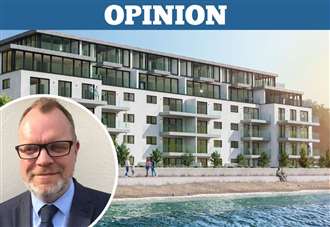Here’s a very modern-day dilemma for you. If, as it seems inevitable, more homes will be built near where you live, what would you rather they be – pricey apartments or social housing?
I ask, because earlier this week there was uproar about a swanky development in Hythe where the ‘cheapest’ flats at a new seafront site had a starting price of £400,000. Expensive by anyone’s standards.

It’s not alone, either. When Ramsgate finally resolved the years-long neglected and ugly Pleasurama site drama by the construction of a modern apartment block yards from the sandy beach, prices for apartments cost as much as £750,000.
And, of course, then there’s all the work going on in Folkestone where even the developers admit shifting the new apartments – starting price £330,000 – is not easy.
All have received plenty of vocal criticism about how the properties are priced so high the local population – already struggling to find homes – can’t afford them.
The argument, in truth defies logic.
After all, when did properties commanding views over water ever come cheap? Whether it’s the English Channel, North Sea. Thames Estuary or simply a lake, such prime positions have always come with a premium price tag.

Unless you have an extraordinarily wealthy Bank of Mum and Dad or leap straight into a six-figure salary job, a property in such a spot is not going to be for the first-time buyer.
It is, by its very nature, an aspirational property which occupies a key part in the housing pyramid. “One day,” we all say to ourselves, “we’ll live somewhere like that.”
Except, of course, most of us realise, as we get older, that the same amount of money could buy a bigger house, with more bedrooms and a garden, a mile inland. So opt for that instead.
But others will want to pay to wake up to the sound of seagulls and the sight of sewage lapping at our shores.
As communities, however, we need to be realistic.

Would those local residents complaining be any happier if rather than a plush seafront development, it was instead a newly-built packed-in council estate?
Chances are they’d be complaining that such a prime seafront site should be rather more in keeping with the – here’s that word again – aspirations of the area.
So developers pay big money for such sites and, more often than not, opt for apartments to maximise revenues while keeping prices sub seven-figures.
They’ll attract buyers with deep pockets and plenty left over to pump into the local shops and restaurants, enriching the wider local economy. Any district worth its salt wants that sort of development in the hope that money follows money. Plus, it breathes new life into areas, like it or not.
Yet, of course, it’s not actually what Kent needs to solve its part of the housing crisis.

No, the real need is the unsexy social housing – entry-level homes for those either in or at risk of being stuck in some of the God-awful temporary accommodation we hear so much about. After that, it’s affordable homes which don’t take a lifetime to try and raise a deposit for.
But seafronts aren’t going to be the place for them. So don’t ever expect them to be.
The housing market has always operated on the same principle; a cascading level of properties with those at the very top being in the most desirable spots or with the largest floorspace.
The trick is to ensure for every glass-fronted seaside apartment block with underground parking and granite-topped kitchen, there are triple the number of properties which those at the opposite end of the market can afford to live in.
Solve that dilemma and the housing crisis will be no more.
